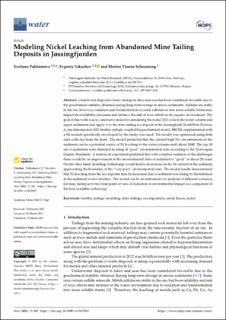| dc.contributor.author | Pakhomova, Svetlana | |
| dc.contributor.author | Yakushev, Evgeniy | |
| dc.contributor.author | Schaanning, Morten | |
| dc.date.accessioned | 2021-07-23T07:16:01Z | |
| dc.date.available | 2021-07-23T07:16:01Z | |
| dc.date.created | 2021-07-21T15:18:28Z | |
| dc.date.issued | 2021 | |
| dc.identifier.citation | Water. 2021, 13 (7), 967. | en_US |
| dc.identifier.issn | 2073-4441 | |
| dc.identifier.uri | https://hdl.handle.net/11250/2765149 | |
| dc.description.abstract | Underwater disposal of mine tailings in lakes and seas has been considered favorable due to the geochemical stability obtained during long-term storage in anoxic sediments. Sulfides are stable in the ore; however, oxidation and transformation of some substances into more soluble forms may impact bioavailability processes and enhance the risk of toxic effects in the aquatic environment. The goal of this work was to construct a model for simulating the nickel (Ni) cycle in the water column and upper sediments and apply it to the mine tailing sea deposit in the Jøssingfjord, SouthWest Norway. A one-dimensional (1D) benthic–pelagic coupled biogeochemical model, BROM, supplemented with a Ni module specifically developed for the study was used. The model was optimized using field data collected from the fjord. The model predicted that the current high Ni concentrations in the sediment can be a potential source of Ni leaching to the water column until about 2040. The top 10 cm of sediments were classified as being of “poor” environmental state according to the Norwegian Quality Standards. A numerical experiment predicted that with complete cessation of the discharges there would be an improvement in the environmental state of sediment to “good” in about 20 years. On the other hand, doubling of discharge would lead to an increase in the Ni content in the sediment, approaching the boundary of the “very poor” environmental state. The model results demonstrated that Ni leaching from the sea deposits may be increased due to sediment reworking by bioturbation at the sediment–water interface. The model can be an instrument for analysis of different scenarios for mine tailing activities from point of view of reduction of environmental impact as a component of the best available technology. | en_US |
| dc.language.iso | eng | en_US |
| dc.rights | Navngivelse 4.0 Internasjonal | * |
| dc.rights.uri | http://creativecommons.org/licenses/by/4.0/deed.no | * |
| dc.title | Modeling Nickel Leaching from Abandoned Mine Tailing Deposits in Jøssingfjorden | en_US |
| dc.type | Peer reviewed | en_US |
| dc.type | Journal article | en_US |
| dc.description.version | publishedVersion | en_US |
| dc.rights.holder | © 2021 by the authors. | en_US |
| dc.source.pagenumber | 17 | en_US |
| dc.source.volume | 13 | en_US |
| dc.source.journal | Water | en_US |
| dc.source.issue | 7 | en_US |
| dc.identifier.doi | 10.3390/w13070967 | |
| dc.identifier.cristin | 1922362 | |
| dc.relation.project | Norges forskningsråd: 272749 | en_US |
| dc.relation.project | Norges forskningsråd: 236658 | en_US |
| dc.source.articlenumber | 967 | en_US |
| cristin.ispublished | true | |
| cristin.fulltext | original | |
| cristin.qualitycode | 1 | |

